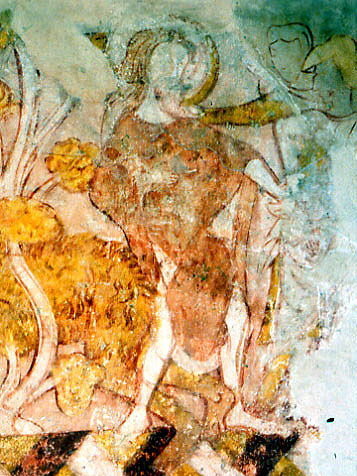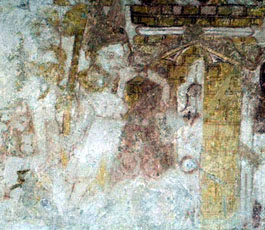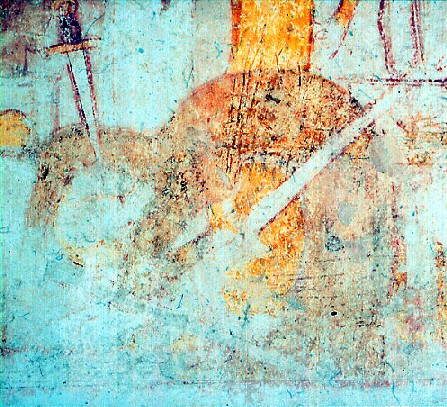Old Idsworth, Hampshire, (†Portsmouth) c.1330
Martyrdom of St John the Baptist
Herod’s Feast, with Salome’s Dance

The scene shown at the left – the imprisonment of John the Baptist, is the first in this narrative, but it is painted in a tier above the principal scene, and follows on directly from an entirely different painting of The Legend of the Hairy Anchorite. John is in the centre, and the details at the left of the scene belong to the Hairy Anchorite painting referred to.
At the right, two men seize the saint, who is bearded and dressed in a loose garment traditionally said to have been made of camel skin during his period in the wilderness of Judea.
Further right is an area of blank wall*, and the story continues below in the lower tier of the painting.
At the far left in this tier are some faint and faded details, probably to do with the seizing of John, and the first identifiable scene in this tier (photo, next left below) shows what little is visible of John – a vague red shape in the approximate centre of this photo – being thrust into a prison cell with a barred window by a jailer holding a club.

Next, further right and shown below at the left, comes Herod’s Feast Various dignitaries – the ‘captains’¹ who were the guests at the Feast – sit at a long table. Herodias, wife of Herod, whose marriage to him John considered incestuous, is the second complete figure from the left, with Herod himself second from the right at the farther side. It is difficult to be certain exactly who the central figures are; the story of the Feast is narrated in several ‘moments’ and Salome herself certainly appears more than once at the table.
A central figure in white (probably faded from another colour), is shown turning in the direction of Herodias at the left. This figure is holding the head of the Baptist on a charger in her left hand, the right hand upraised in a gesture suggestive of triumphant accomplishment – ‘and the damsel gave it to her mother…’².

Various reactions of satisfaction, distaste, and general consternation show in the gestures of the surrounding figures. Below (i.e. on the opposite side of the table, and shown as a simultaneous event, as usual), Salome performs her dance.
The unusual feature here is the presence of a number of swords, wielded by Salome as she dances, body bent backwards with her head almost touching the ground (detail, right, below). Each hand holds a sword, and that in Salome’s right points straight at Herod. A third sword, its red hilt showing clearly, seems to be held by the point of its blade in her mouth.

Although there are other wall paintings showing Salome’s dance in the English church – at Chalfont St Giles, Heydon and (forthcoming) Pickering, the inclusion of the swords is a detail exclusive to the Idsworth example. The most intriguing question, though, is whether this vignette of murderous lust has some connection with the strange painting of The Legend of the Hairy Anchorite which accompanies it in the church (and which in its written form includes its own account of lust-driven, and indeed incestuous, murder). All that can be said with certainty is that witches were commonly held to have the power to change men into beasts and that Herodias was regarded, at least according to the Malleus Maleficarum, as a leader of witches:
“It cannot be admitted as true that certain wicked women, perverted by Satan and seduced by the illusions and phantasms of devils, do actually, as they believe and profess, ride in the night-time on certain beasts with Diana, a goddess of the Pagans, or with Herodias and an innumerable multitude of women, and in the untimely silence of the night pass over immense tracts of land and have to obey her in all things as their mistress, etc…” ³
Sprenger and Kramer add a pious injunction to the ‘priests of God’ to tell the people that this night-riding is of course not a fact, but a delusion sent by Satan himself to confuse the faithful. The identification of Herodias with witchcraft is nevertheless clear, and Sprenger and Kramer throughout the Malleus insist on female sexuality as the wellspring of witchcraft.
Also here, in addition to the painting of the Legend of the Hairy Anchorite, are SS Peter and Paul, the original dedicatees of the church, accompanied by angels, around the chancel arch. These will be on the website in due course.
Website of St Hubert’s, Idsworth
* The Victoria County History has this to say: ‘A curious feature is the small twelfth-century arch, only 21 in. wide, at the east end of the north wall of the nave, and now blocked up. Its inner face is hidden by the pulpit, which stands in the north-east angle, and its original purpose can only be guessed at, though it must have opened to some small building, whether turret, porch, or chapel, set against the north wall of the church’. Given this hiatus, where a scene, perhaps of the Baptist rebuking Herod (as at Cerne Abbas) might have been expected, the resumption of the story below, and the relationship between the two principal paintings at Idsworth, was this, I wonder, the opening to an anchorite’s cell? A surviving one is in a similar position in relation to the north nave wall at Staplehurst church in Kent. From: 'Parishes: Chalton', A History of the County of Hampshire: Volume 3 (1908), pp. 102-110.
¹ Mark 6:21
² Mark 6:28
³ J Sprenger & H Kramer, Malleus Maleficarum, trs. M. Summers, 3rd edn. Folio Society, 1968, Ch. 3, p.63